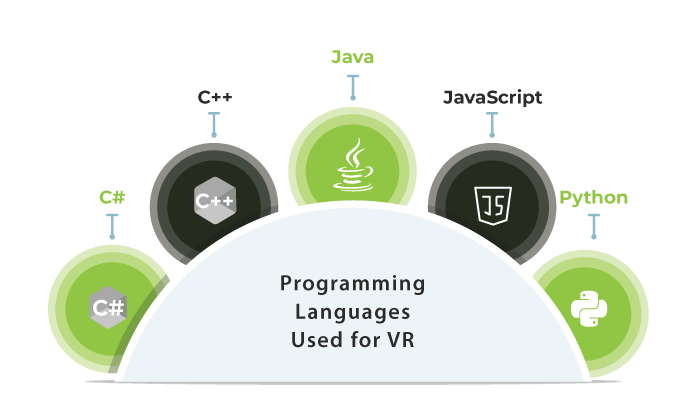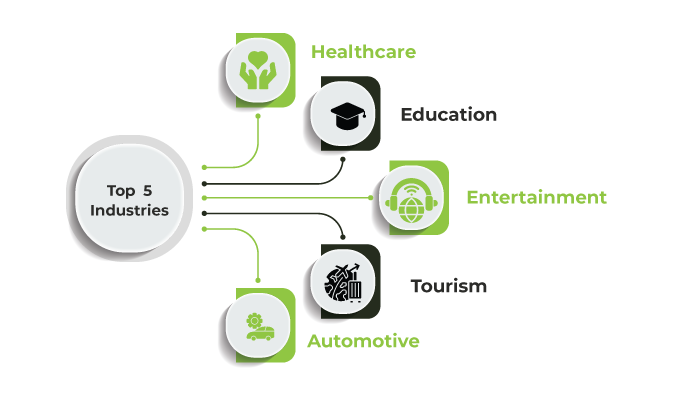Virtual reality is not just” science fiction” anymore but industries using virtual reality to provide services to a whole new level. With the innovation in this technology more uses of VR are surfacing from gaming to healthcare everyone is enjoying VR. Some of the primary industries are already using this technology and providing benefits to their users.
When we ask a question like this, we look for practical answers, how VR is transforming industries?
We can say that VR technology has evolved over the past few years and the impact it creates on the industry is beyond imagination. VR is providing innovative solutions for a wide range of apps that transforms the way we interact with reality. This technology has several uses, especially in the education, healthcare, military and retail sectors.
Futurist Kevin Kelly delivered a statement in 2016 at ‘The SXSW Interactive conference in Austin, citing ‘Virtuality’ ( Augmented reality, Virtual Reality and everything in between ) as three major forces that are going to change our lives in the next ten years. As a founding executive director of Wired magazine, he is optimistic about VR and when he makes predictions, everybody believes.
This technology has the power to change our world. So if you are planning to launch your virtual reality app, now is the right time to do it.
In the blog, we will talk briefly about how VR is transforming industries and Metaverse vs. Virtual reality, the programming languages used for developing VR and the top five industries that are using virtual reality apps.
So without wasting further time let’s dive right into the blog.
Bringing Imagination to reality: How VR is Transforming Industries?
Virtual reality is a simulated experience that gives users Virtual reality solutions. This technology enables a user to interact with the virtual surroundings in a way that feels most like reality. Most people are familiar with VR as it is helpful in education, training, healthcare and other industries. The environment is created with software and hardware, although the user might need to wear devices such as goggles and helmets to interact with the environment.
Moreover, other VR experiences involve multi-projected environments which include more heightened senses like touch which brings imagination to reality.
Oculus Rift and Samsung Gear VR maintain some of the most popular and expensive VR headsets. These are connected to virtual experiences that can be accessed via video game consoles and smart devices. When it comes down to VR development cost it depends on whether you want to develop a mobile VR application and mobile VR gaming app.
However, the potential of VR is limitless, and this technology is continuously on the path of advancement. It will continue to revolutionize the way we work, play and live. VR technology is transforming industries by bringing imagination to reality. The similarity to virtual reality is impossible to overlook while reading about Metaverse. Let’s discuss this in the next section.
Metaverse vs. Virtual Reality
Metaverse is an embodied network where you are present in the material rather than just watching it. According to the Microsoft release, Metaverse is a persistent digital environment populated by technologies of places, people and objects.
Metaverse |
Virtual Reality |
| It’s an open shared virtual world with 3D virtual spaces where users can explore; interact with other users as digital avatars. | VR is the technology for creating 3D environments with elements of touch, sight and sound. |
| Metaverse gets support from various technologies like VR, AR and connectivity technologies. | Virtual reality services are limited and could only go to the extent of providing simulated 3D environments. |
| Could also include augmented reality and be accessed through other devices. | Individual experiences are not linked. |
| This could include, gaming, working, shopping and many more | This platform is largely closed. |
| Metaverse is a shared experience this virtual world will exist even when you are not in the Metaverse | The VR experience of a user stops immediately when the user switches off their devices. |
Metaverse and VR are intertwined, but virtual reality is a technology that let you experience virtual worlds. In addition, the metaverse will likely be accessible through virtual reality but also through augmented reality, even traditional devices like phones and computers.
What Programming languages Are Used For VR?

When it comes to providing amazing VR solutions, not every programming language is a good fit for VR development. There are only a few specific languages that can get the job done.
Here are the top five programming languages that are used for VR development.
1. C#
This is a general purpose multi-paradigm language and includes the cross-platform mobile development framework called the game engine Unity. In addition, Unity is especially important for building VR applications as a platform for real-time 3D and 2D game development.
2. C++
C++ is an extension of C, it’s a popular middle-level programming language, that includes C++ naturally. It has the benefits of low-level memory manipulation that makes them more viable to work closely with hardware.
Moreover, the language is used in another game engine, Unreal engine. It’s the world’s most advanced real-time 3D creation tool for virtual worlds which is appropriate for VR development.
3. Java
It is the most popular programming language; it mirrors the memory management in languages like C# and C++ and its large set of in-built libraries makes Java an amazing language for building VR environments.
4. JavaScript
JavaScript is popular by being one of the very first languages to allow for dynamic web development. Most web browsers rely on JavaScript which makes languages suitable for WebXR device API, a platform that enables VR through your browser.
5. Python
Developers love Python, the first four languages are the best to pick for virtual reality development but Python is pretty straightforward and accelerates project development, especially for VR.
Moreover, the languages come equipped with several packages that can simplify the building of VR applications. Several industries use virtual reality to boost their business growth by using these programming languages for VR development. Now if you want to know more about the top five industries that are using Virtual reality apps read the next section.
Top 5 Industries Using Virtual Reality Apps

Virtual reality has been a topic of conversation for centuries and industries using virtual reality for the past few years. This is the only technology that has emerged to transform fantasy into reality. Usually, people associated Virtual reality with gaming and entertainment but this technology has evolved and served various industries.
Here we have researched and created a list of the top five industries using virtual reality apps.
1) Healthcare
Virtual reality in the healthcare sector is providing services through training. It facilitates an environment to learn and grow outside in real-world situations. Moreover, with VR doctors can practise precise operations without being get caught in an emergency.
Practitioners who want to get familiar with the hospital environment can practise without being in a stressful environment. Usually, this technology is used in cognitive behaviour therapy where patients’ phobias and anxieties are treated in a controlled environment.
Uses of VR in the Healthcare industry:
- Anatomy and social medical skills learning
- Practising complex surgeries
- Medical equipment use training
- Curing mental pain and anxiety
- Neurological rehabilitation
- Cognitive abilities improvement
2) Education
Virtual reality enhances education learning and improves student success outcomes by creating an amazing learning experience. Moreover, it is used to provide training to students and faculty members and users can study objects like exploring human anatomy, studying ancient civilizations like Egypt and many more. VR is revolutionizing the education sector by providing a more realistic approach and high-quality results.
In addition, virtual reality educational uses can improve teamwork and social skills by creating exciting collaborative learning environments. It not only improves learning skills but results in multiple benefits of time, cost and technique for both the learning and teaching community.
Uses of VR in the education industry:
- Improve engagement in the educational process
- Gamification can simplify learning
- Time management with creativity development
- Increased motivation for visual learning
3) Entertainment
When it comes to the entertainment industry they are using VR technology in numerous activities. Some of these activities are riding a roller coaster, movies, playing games and dropping off from height. These activities bring thrill and fun at the same time.
Moreover, it offers endless opportunities to experience music in an immersive way which keeps the user engaged.
The VR live concerts have an amazing experience for both the host and the artist which is included in one of the best advantages of virtual reality in entertainment zone. The global VR gaming market alone was valued at $11.5 billion in 2019 and is predicted to grow at an annual rate of 30% from 2020 to 2027.
Uses of VR in the entertainment industry:
- Virtual theme parks or VR theme parks rides
- Discovery centres
- Virtual reality movie centres and theatres
- Live performances, Virtual reality live concert hosting
- Gaming and home entertainment
4) Tourism
When people are quarantined, in lockdowns and maintain social distancing tourism falls the hardest hit. While one cannot physically travel, but still feel the need to explore to new places and destinations which can be possible with virtual reality.
It provides guided virtual tours of landmarks, hotels, restaurants and whichever place you want to visit on your next vacation. With this people can stay in the same location but virtually visit any place around the world.
Samsung’s VR lunar experience was created with NASA which allows anyone to explore the lunar surface which is amazing.
However, virtual reality in tourism industry becomes the medium of adventure and tourism companies are using this to the best of their advantage. Now they can attract more visitors by showing them real-time images and videos.
Uses of VR in the tourism industry:
- Showcase the beauty of each property
- Travellers can get a 3D tour before visiting the sites
- Show multiple properties at one time
- Travellers can use VR technology when there are delays in the travel schedule
5) Automotive
Virtual reality in automotive industry is integrating new technologies for the research, design and production of vehicles.
However, prototyping became easy with Virtual reality engineers and technicians who can directly interact with the prototypes. VR simplify the effort and time used for building the complicated process of building bulky physical prototypes.
On the other hand, the production process for vehicles is complex, and time is vital in ensuring competitiveness and maximising the benefits of innovation and research.
Moreover, virtual prototyping also simplifies development and research, accelerates the design process and reduces the number of adjustment rounds.
Uses of VR in the Automotive industry:
- Technician training
- Vehicle operation learning
- Prototyping and design
- Remote Collaboration
- Automotive production processes
Conclusion
By going through the blog you can get to know about the Industries Using Virtual Reality for boosting their business growth. If you want to do the same, simply hire dedicated developers they can simplify the Virtual reality development and you can successfully launch your VR app in the market.
If you want to know more regarding Virtual Reality development feel free to reach out to us.

Niketan Sharma is the CTO of Nimble AppGenie, a prominent website and mobile app development company in the USA that is delivering excellence with a commitment to boosting business growth & maximizing customer satisfaction. He is a highly motivated individual who helps SMEs and startups grow in this dynamic market with the latest technology and innovation.
Table of Contents





No Comments
Comments are closed.